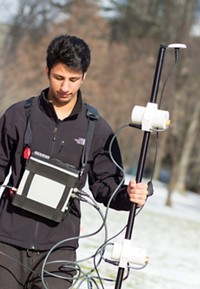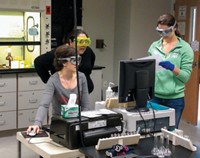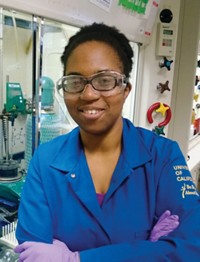Advertisement
Grab your lab coat. Let's get started
Welcome!
Welcome!
Create an account below to get 6 C&EN articles per month, receive newsletters and more - all free.
It seems this is your first time logging in online. Please enter the following information to continue.
As an ACS member you automatically get access to this site. All we need is few more details to create your reading experience.
Not you? Sign in with a different account.
Not you? Sign in with a different account.
ERROR 1
ERROR 1
ERROR 2
ERROR 2
ERROR 2
ERROR 2
ERROR 2
Password and Confirm password must match.
If you have an ACS member number, please enter it here so we can link this account to your membership. (optional)
ERROR 2
ACS values your privacy. By submitting your information, you are gaining access to C&EN and subscribing to our weekly newsletter. We use the information you provide to make your reading experience better, and we will never sell your data to third party members.
Education
David J. Asai
HHMI education director discusses coming changes in institute’s education funding
by Celia Henry Arnaud
May 9, 2011
| A version of this story appeared in
Volume 89, Issue 19
Howard Hughes Medical Institute announced last month its next competition for undergraduate colleges and universities. HHMI has invited 215 institutions to compete for up to $60 million in science education funding. Colleges that accept the invitation can expect some changes from previous HHMI competitions. C&EN sat down with David J. Asai, director of the precollege and undergraduate science education program at HHMI, to talk about the rationale for those changes and what they might mean for grant recipients.
The first change requires that schools radically rethink how they organize their grant applications, Asai says. HHMI’s program underwrites activities in student research, faculty development, curriculum development, and outreach. In the past, the institute encouraged a “food groups” approach to such programs.
Changes Afoot
HHMI introduces changes to Undergraduate Science Education Program.
• Applicants must structure their proposals around an overarching objective.
• Groups of up to three institutions may apply for joint projects.
• Longtime grant recipients must shoulder part of the cost of successful programs.
“If you think about the food pyramid, the whole idea is that if you don’t partake of each of those food groups, you’re malnourished,” Asai says. “We want to get away from that connotation. You can be doing something really well and not be doing all four of those activities, or you could be doing all four of those activities and not have a clear vision of where you’re trying to go with your students.” HHMI plans to compel its grant recipients to establish that clear vision.
This time, proposals must be structured around one overarching objective and lay out how each activity will help the school meet that objective.
Although the requirement marks a major shift in the HHMI program, Asai hopes that educators will see parallels to the way they write research proposals.
“A good research grant would make the overall objective very clear at the top—‘I want to understand X,’ ” he says. “And then you have specific aims: ‘In order to gain that understanding, I need to do A, B, and C.’ ”
If the proposal is well structured around an important goal, then each program can be assessed in terms of how well it helps meet that goal, Asai says.
Another big change is that schools will have the opportunity to submit joint grant proposals. In the past, schools could collaborate with any institution that seemed appropriate, but the grant belonged to just one institution.
Now, if they choose, invited schools can band together in groups of up to three institutions for a single proposal in which they can ask for budgets of up to three times the maximum for a single institution. (Individual institutions can ask for $200,000–$400,000 per year for the four-year grant.)
“They don’t have to divide it evenly,” Asai says. “You would expect that these three schools would have different needs and different strengths. If they’re in fact identical schools, it would be harder to make a compelling case for a joint project.”
Joint projects could take a number of forms, Asai says, depending on the geographic proximity of the partners. Schools that are near each other might develop shared classes for which students or faculty would commute between campuses. But schools separated by long distances could exchange faculty for a semester or students during the summer, he says.
The potential snag is that an institution can apply only once, either individually or as part of a group. “There’s a risk going into a joint project,” Asai says. Schools that have previously received funding on their own run the risk of getting nothing if a joint proposal is poorly reviewed. “These joint proposals will seem natural sometimes, and sometimes they won’t make sense. It will be interesting to see how many joint proposals we receive and how schools choose to exploit this opportunity.”
The third change is that for the first time HHMI is asking schools that have received funding in four or more previous competitions to share the cost of the programs. The percentage a school will be asked to shoulder will depend on how many education grants they have received from HHMI. Schools with four prior grants must pay for 4% of the new grant; those with five must pay 8%; and those with six will pay 12%.
Asai hopes that asking schools to bear some of the cost will lead them to figure out how to sustain successful programs in the absence of grant funding. “This is a handoff,” he says.
HHMI runs separate competitions for research universities and undergraduate colleges, inviting approximately 200 schools for each competition and awarding approximately 50 grants. These changes are currently being rolled out for the college program, applications for which are due Oct. 4, but Asai expects changes will also be implemented for the next research university competition in 2013.
“The philosophical shift we’ve had is an important one and is not dependent on the kind of institution,” Asai says. “We want you to have an overarching objective; we want you to think about joint projects; and we want you to help share some of the cost of successful ideas. Those sorts of ideas should apply to everybody.”






Join the conversation
Contact the reporter
Submit a Letter to the Editor for publication
Engage with us on Twitter